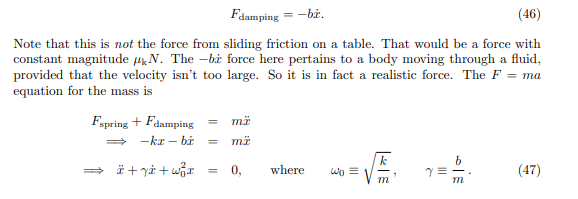The result you got above should be x(t) = e(C + Dt), eq 77. This introduces a new solution to the differential equation of motion, namely x(t) = Dte. Show directly that this is a solution of eq. 47 for y/2 = Mo-
The result you got above should be x(t) = e(C + Dt), eq 77. This introduces a new solution to the differential equation of motion, namely x(t) = Dte. Show directly that this is a solution of eq. 47 for y/2 = Mo-
Related questions
Question

Transcribed Image Text:The result you got above should be x(t) = e(C + Dt), eq 77. This introduces a
new solution to the differential equation of motion, namely x(t) = Dte. Show
directly that this is a solution of eq. 47 for y/2 = @.

Transcribed Image Text:Fdamping = -bż.
(46)
Note that this is not the force from sliding friction on a table. That would be a force with
constant magnitude HN. The -bi force here pertains to a body moving through a fluid,
provided that the velocity isn't too large. So it is in fact a realistic force. The F = ma
equation for the mass is
Fspring + Fdamping
-kr – bi
k
» i + yå + wr
0,
where
wo =
(47)
m
Expert Solution
This question has been solved!
Explore an expertly crafted, step-by-step solution for a thorough understanding of key concepts.
Step by step
Solved in 3 steps
